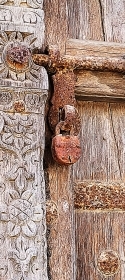Adam Yamey's Blog: YAMEY, page 23
February 23, 2025
Two disappointments in London town
JUST IN CASE you are tempted to see them, here are two events in London, which I found disappointing. One of them is the Silk Roads exhibition at the British Museum. It was crowded, insubstantial, and resembled a badly lit antiques fair.
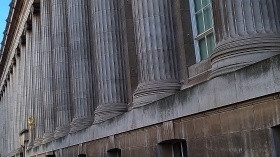
The other is the film “The Brutalist”. It is over three hours long, but that is not what irritated me. It was a gratuitous, self-indulgent, uninteresting ‘mish-mash’ of irrelevant story-telling. The only mitigating aspect of this film was the actor Adrien Brody, but I felt sorry that his talents were expended on such a pointless film.
On a positive note, I can strongly recommend viewing the excellent exhibition of Picasso’s prints at the British Museum.
February 22, 2025
The man who helped make English a language of India
THOMAS BABINGTON MACAULAY (1800-1859) was a genius, a reformer, a historian, an impressive and persuasive orator, a voracious reader, and a politician (Whig party). He was actively involved in abolishing the slave trade, emancipating the Roman Catholics and the Jewish people in Britain, and extending the right to vote. Yet despite his liberal views and actions, he was what many people might consider ‘politically incorrect’ by today’s standards. For example, even though he promoted the rights of Jewish people, he was quite anti-Semitic. As far as voting was concerned, he wanted to expand the electorate but only to those whose education was above a certain standard.
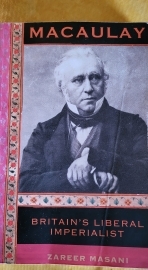
Macaulay spent several years in India, working for the East India Company and the British Government. He was disdainful of the long tradition of Hindu literature, customs, and knowledge. He felt that the way forward for the Indian Subcontinent lay in providing the Indians with what he considered to be the superior knowledge of Western (European) science, philosophy, and other aspects of life. To this end, he encouraged the teaching of English to Indians so that they could ‘enjoy’ the benefits of Western ‘civilisation’.. It is largely due to his efforts in promoting teaching of English, and other subjects in English, that today English is a flourishing language ( a ‘lingua franca’) in India and other parts of the Subcontinent..
An Indian academic Zareer Masani (1947-2024) has written a superbly detailed biography of Macaulay. Called “Macaulay”, this biography skilfully recounts the life of this fascinating man. It is a scholarly but highly readable account of a brilliant man who achieved a great deal and whose life was not free of contradictory traits. With regard to Macaulay’s encouragement of the use of English in India, Masani wrote that Macaulay was much admired by BR Ambedkar, who was born a Dalit and worked to improve the lot of Dalits. He was also the author of the Constitution of Independent India. Ambedkar, who admired Macaulay, benefitted from Macaulay’s encouragement of Western education as opposed to the revival of Indian nationalist traditions. Without Western education, which Macaulay insisted was to be made available to all Indians regardless of their religion or caste, BR Ambedkar, coming from humble background, might never have had the excellent educational opportunities he enjoyed.
I can strongly recommend this book. It was a joy to read.
February 21, 2025
Sunset on the British Empire
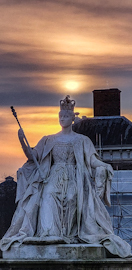
The sun never sets
On the mighty British Empire
So it was said
February 20, 2025
A prolific artist and his amazing output of prints
SOME MIGHT DISAGREE with me, but I was extremely unimpressed by the “Silk Roads” exhibition that is being shown at London’s British Museum (‘BM’) until 23 February 2025. It seemed to be like an overcrowded, poorly lit antiques fair. Additionally, it appeared to be a rather sketchy overview of what is a highly interesting period in the history of international trade. In contrast to the over-hyped Silk Roads show, another exhibition, “Picasso Printmaker”, showing at the BM until 30 March 2025 is magnificent.
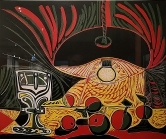
Just as Rembrandt (1606-1669) was one of the best European painters of the seventeenth century, Picasso (1881-1973) was one of the best European painters of the twentieth century. Like Rembrandt, Picasso not only painted but also created prints. During his life, Picasso created at least 2400 prints. The BM has by far the UK’s largest and most representative collection of his prints. Some of these are on display in the beautifully curated show at the museum. The exhibition displays a series of Picasso’s prints ranging from some of the earliest (created around 1905) to those he made during the very last days of his life.
The prints on display were made using several techniques including: aquatint, drypoint (engraving), etching, linocut, lithograph, sugar aquatint, and transfer lithography. He learned these techniques from some of the best printers in France, and experimented with methods of his own. Many of the exhibits are prints made with black ink on white paper, but a few contain other colours. Although the black on white images are of the highest artistic quality, the coloured prints are particularly spectacular
The prints on display at the BM illustrate that throughout his long creative life, Picasso was a highly skilled artist who was not lacking in imagination. Each print in the exhibition increased my appreciation and admiration of Picasso’s artistic output. This exhibition should not be missed if you are keen on twentieth century art and are spending time in London.
A prolific artists and his amazing output of prints
SOME MIGHT DISAGREE with me, but I was extremely unimpressed by the “Silk Roads” exhibition that is being shown at London’s British Museum (‘BM’) until 23 February 2025. It seemed to be like an overcrowded, poorly lit antiques fair. Additionally, it appeared to be a rather sketchy overview of what is a highly interesting period in the history of international trade. In contrast to the over-hyped Silk Roads show, another exhibition, “Picasso Printmaker”, showing at the BM until 30 March 2025 is magnificent.

Just as Rembrandt (1606-1669) was one of the best European painters of the seventeenth century, Picasso (1881-1973) was one of the best European painters of the twentieth century. Like Rembrandt, Picasso not only painted but also created prints. During his life, Picasso created at least 2400 prints. The BM has by far the UK’s largest and most representative collection of his prints. Some of these are on display in the beautifully curated show at the museum. The exhibition displays a series of Picasso’s prints ranging from some of the earliest (created around 1905) to those he made during the very last days of his life.
The prints on display were made using several techniques including: aquatint, drypoint (engraving), etching, linocut, lithograph, sugar aquatint, and transfer lithography. He learned these techniques from some of the best printers in France, and experimented with methods of his own. Many of the exhibits are prints made with black ink on white paper, but a few contain other colours. Although the black on white images are of the highest artistic quality, the coloured prints are particularly spectacular
The prints on display at the BM illustrate that throughout his long creative life, Picasso was a highly skilled artist who was not lacking in imagination. Each print in the exhibition increased my appreciation and admiration of Picasso’s artistic output. This exhibition should not be missed if you are keen on twentieth century art and are spending time in London.
February 19, 2025
Walking along the path of peace along the Western Front
WHEN I SPOTTED THE book in the shelves of a charity shop in the small town of Bruton (in Somerset), I knew I had to buy it. It is written by Anthony Seldon, the youngest son of my parents’ dearest friends, Marjorie and Arthur Seldon. I have known them and Anthony since I was a very young child. The book I purchased is called “The Path of Peace. Walking the Western Front Way”.
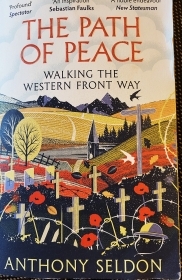
In 2021, when Europe was in the midst of the covid19 pandemic, Anthony decided to walk from the Swiss Border to the North Sea, following the path of the Western Front such as it was during WW1. His aim was to help establish a ‘Path of Peace’, to realise the idea formulated during the war by one of the millions who died during it (in 1915), Douglas Gillespie. His idea was, so he wrote to his parents, to establish:
“… a path along No Mans Land from Switzerland to the English Channel after the war was over.”
Douglas wrote to his old headmaster at Winchester College that when the path was established:
“… I would like to send every man [woman] and child in Western Europe along that Via Sacra, so that they might think and learn what war means from the silent witnesses on either side.”
And Anthony explained that the walk he undertook was to help fulfil this noble ambition of poor Gillespie who perished in the conflict.
The book describes Anthony’s arduous walk along the Western Front. It was arduous physically, as the author explained in graphic detail. His feet suffered greatly, almost as much as those of the soldiers who had to spend long periods in the unhygienic trenches. It was also arduous for Anthony because he had recently lost his first wife, Joanna, who had succumbed to an illness (not covid19). The various governmental restrictions imposed to control the pandemic added to his difficulties. Yet, despite many businesses having shut down in France because of the virus, he managed (occasionally with difficulty) to find food and accommodation along the way.
Anthony describes many interesting aspects of the history of WW1 as he made his way north from Switzerland to the North Sea. He mentions what has become of the many places that were heavily destroyed by the artilleries of the armies fighting each other. Intertwined with these historical facts of an impersonal nature, he relates the poignant histories of his parents’ families during the war. For example, he describes how his father was orphaned when his parents died during the Spanish Flu, the spread of which was facilitated by wartime conditions. He also describes how his mother’s father was badly wounded in France and how his wife, Anthony’s grandmother, defied British officialdom and rescued her wounded husband from war torn France. These aspects of Anthony’s family history were known to me before I found the book, but what her wrote adds greatly to what I already knew.
Throughout the book, Anthony muses on the horrors of warfare and its tragic consequences. Yet, the book is not as gloomy as its subject matter might suggest. As the reader follows his progress along a frequently ill-signposted trail, he or she gets to know Anthony better: his strengths and his self-confessed weaknesses. Anthony’s book is both fascinating and moving. I am glad I bought my copy when I saw it in Bruton.
February 18, 2025
Passwords
February 17, 2025
See it, savour it, but do not put it in your mouth
IF YOU HAVE NEVER heard of ‘shokuhin sanpuru’, you are not alone. It was only after visiting an exhibition called “Looks Delicious” at Japan House in London’s High Street Kensington on its penultimate day (15 February 2025) that I realised that I had often seen examples of shokuhin sanpuru (replicas of food) without realising what they are called in Japanese.
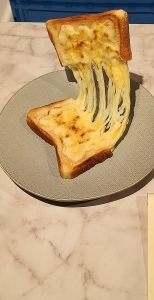 Replica of toast with melted cheese
Replica of toast with melted cheeseJapanese restaurants and eateries display lifelike replicas of the food they offer to customers. They are designed both to show the customer both what to expect and to entice him or her to enter the establishment to order and then eat their kitchen’s fare. The replicas are ‘hyper-realistic’. These mouthwatering looking models are both informative and of a commercial nature: they are designed not only to depict the dishes but also to evoke in the viewer’s mind the desire to consume them. According to the exhibition catalogue (see: https://www.japanhouselondon.uk/whats-on/looks-delicious-exploring-japans-food-replica-culture/) the origin of these replicas:
“… can be traced back to the early 20th century. As ‘Western’ cuisine grew in popularity in Japan, restaurateurs needed a way to visually communicate their menus to a curious yet cautious public. Food replicas were made entirely out of wax until the 1970s, when the introduction of synthetic resin transformed their production, allowing for greater detail, durability and more dynamic display.”
The catalogue noted:
“Every effort is made to ensure food replicas appear as realistic as possible. Food replica craftspeople not only reproduce the appearance of food; they also recreate the memory of it in people’s imaginations. For example, while red bean paste may, in reality, not be that grainy, people often associate it with a grainy texture.”
The exhibition at Japan House includes examples of replicas of many kinds of Japanese food as well as of European (‘Western’) dishes. As the catalogue explained, the replicas are not only made to entice customers into eateries, but also for other purposes:
“Beyond their use as a marketing tool, food-replica technology also has wide ranging applications, notably in nutritional education and medical science.”
In addition, replicas can be made to be used as standards by which the appearance of actual food products and ingredients can be assessed.
The show at Japan House includes models and films showing how the replicas are created. Often the real food is coated with a liquid material that is used to make a three-dimensional impression (mould) of the dish. The food is then removed from the newly formed impression, and the detailed impression/mould is then set in a solid base of plaster of Paris. Then, wax or resin is poured into the mould to produce a replica. The replica is then carefully painted to recreate the appearance of the dish or food item. To recreate textural features, such as the delicate marbling on Wagyu beefsteak or fish scales, there are carefully prepared stencils, which can be laid on the models whilst paint is applied through the perforations in them. I have simplified the description of the manufacturing process, but rest assured that the production of these unbelievably realistic replicas can only be done by highly skilled craftsmen.
The unusually fascinating exhibition should not be viewed, as we did, when hungry. The replicas on display can only increase your desire to eat. They looked so enticing that it was difficult not to reach out and pick them up to eat. However, apart from not being allowed to touch them, as realistic as they look, they are completely inedible.
February 16, 2025
Revolt in two colonies of Portugal in western India
THE TOWN OF SILVASSA is just under 100 miles north of Colaba in Bombay. Known to the Portuguese as ‘Paço de Arcos’, it was the administrative capital of their colony of Dadra and Nagar Haveli, now an Indian Union Territory. Dadra is a small district, roughly circular in shape. It is separated from the larger Nagar Haveli by a small stretch of what is now the Indian State of Gujarat. Between about 1780 and 1954, these two landlocked territories were colonies of Portugal.
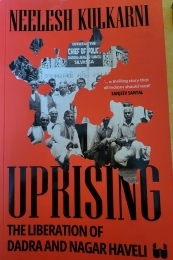
During the period when Portugal ruled Dadra and Nagar Haveli, the indigenous people living there were exploited mercilessly and treated harshly by the Portuguese and wealthy local landlords. Neelesh Kulkarni has recently (2024) published a book, “Uprising: The Liberation of Dadra and Nagar Haveli” which describes the struggle to free the two tiny colonies from Portuguese rule, and their eventual incorporation into the Republic of India. His account is not only based on published sources but also interviews with surviving freedom fighters and members of other fighter’s families.
After 1947, when most of what is now India became independent, Portuguese colonies on the Indian Subcontinent remained territorial possessions of Portugal. Kulkarni relates how at least two groups of freedom fighters struggled to evict the Portuguese from Dadra and Nagar Haveli. The Indian government, under the leadership of Jawaharlal Nehru, who had professed to the world to adhere to the principle of non-violence, was unwilling to send troops into the two rebellious Portuguese territories, yet did nothing to hinder the activities of the rebels. The book shows how the rebels planned their attacks on the Portuguese police and militia, collected funds, accumulated weaponry, recruited fighters and trained them.
Being landlocked and separated from their coastal colonies (Daman being the closest) by land, which after 1947 was Indian sovereign territory, made it difficult for the Portuguese to send military aid to their people in Dadra and Nagar Haveli. The Indian government was unwilling to allow military supplies to pass from Daman and Goa through India to the beleaguered landlocked Portuguese colonies. Using guerilla tactics and aided by the Warli tribal people, who had suffered much at the hands of the Portuguese, the Portuguese were eventually driven out of Dadra and Nagar Haveli. At times the situation was hair-raising, and there was a large possibility that the better armed Portuguese might have suppressed the rebellion.
I began reading Kulkarni’s book while waiting at a departure gate in Bangalore’s international airport, and finished its 220 exciting pages several hours later during a flight to London. His book about a relatively unknown freedom struggle in an obscure colony of Portugal is not only well-researched and interesting, but it is also written like a fast-paced thriller. I am really glad that I bought a copy, and will treasure it amongst my slowly growing collection of books about Gujarat and its history.
February 15, 2025
As experiences of India gradually become memories
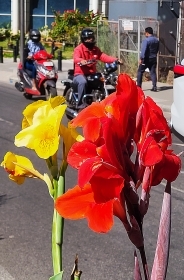
THE BOEING JET began moving away from the oddly designed new terminal at Bangalore’s International Airport. I watched the landscape slipping past ever more quickly as we accelerated along the runway before eventually becoming detached from the soil of India. As the aeroplane rose higher and higher, random things flashed through my mind such as: eating laal maas on a rooftop in Jaisalmer; a Dutch cemetery on the coromandel Coast; hawkers wandering up and down a railway carriage in West Bengal; riding through Bangalore in a Jesus autorickshaw; being asked to bless strangers, a newly married couple, in a church in Pondicherry; tasting nolen gur in Murshidabad; attending an aarti on the Ganges; and much more. After flying over the west coast of India, all of these experiences and a whole host of others that we had enjoyed during our 88 day stay in India became, like the coastline we crossed, distant memories, which I hope will remaine etched permanently in my mind.

